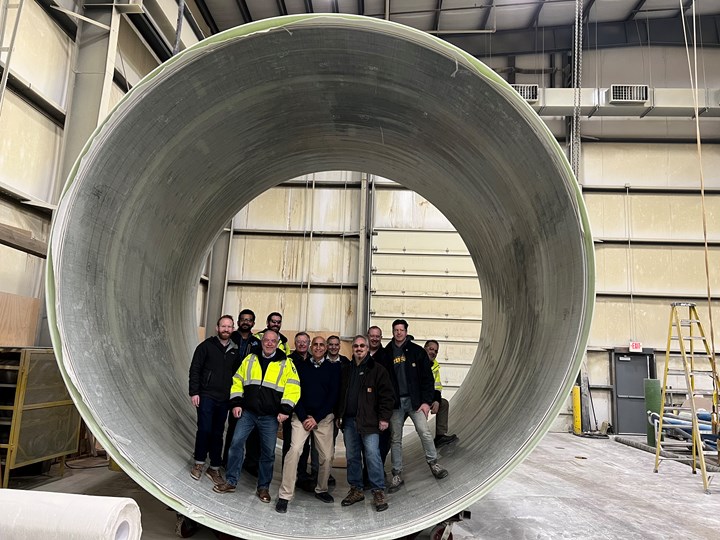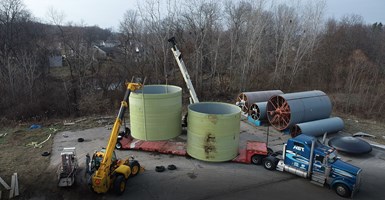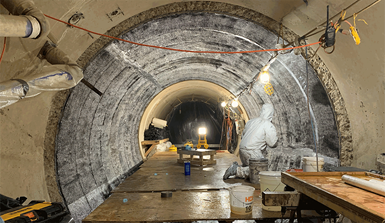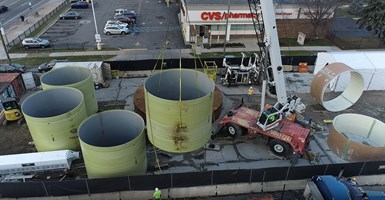
Large and in charge. QuakeWrap team members demonstrate the size of the 16-foot-diameter StifPipe. Photo Credit, all images: QuakeWrap Inc.
For more than two decades, QuakeWrap Inc. (Tucson, Ariz., U.S.) has been developing infrastructure repair solutions using fiber-reinforced polymer (FRP) materials. The company’s large-diameter composite pipes, known as StifPipe, are currently being installed in the City of Detroit, Michigan’s latest sewage infrastructure project.
“What makes the Detroit project unique is that it’s probably the biggest polymer composite pipe in the world,” says Dr. Firat Sever, Pipeline Division manager at QuakeWrap.

The journey ahead. StifPipe components being loaded onto a truck for transport to Detroit.
Earning a part in the project
QuakeWrap first introduced StifPipe in 2016, when it won an American Society of Civil Engineers (ASCE) Innovation Award. Since then, StifPipe has been used in applications across the globe from Puerto Rico to Australia, but none of the previous projects have involved StifPipe at the scale required in the Detroit application. The pipes being installed in Detroit are 16 feet in diameter and only 2 inches thick.
“This pipe has the highest strength-to-weight ratio of any pipe on the market,” contends Dr. Mo Ehsani, founder and president of QuakeWrap. “That makes it really lightweight, and it doesn’t corrode, so it has a lot of advantages. When you use a thicker wall liner that is made of less strong materials, then you will lose hydraulic capacity [the optimal flow of wastewater] and that’s quite important, especially when you convey huge volumes of fluid or water.”
StifPipe is composed of 12 layers of material — four layers of carbon fiber, six layers of glass fiber and two layers of a proprietary core. The carbon and glass fiber fabrics are supplied by Vectorply (Phenix City, Ala., U.S.), and Composite Fabrics of America (Taylorsville, N.C., U.S.), and distributed by 
In 2019, the wastewater Oakland-Macomb Interceptor Drain Drainage District (OMIDDD) and NTH Consultants Ltd. (NTH) conducted an inspection of a portion of the district’s piping that carries sewage from a large pump station in Detroit. After discovering aging segments in need of repair, the wastewater district decided to reline the 17.5-foot-diameter pipes. The pipes transferred over half of Detroit’s wastewater, so they could not be shut off permanently during the relining process. Instead, the flow of sewage could only be temporarily shut off for portions of each day. This would not allow enough time for replacement pipes to be cured in place, so OMIDDD team members sought out pipe technologies that could be manufactured and assembled above ground before being lowered into the sewage system and installed using a slip lining process.
After connecting with QuakeWrap at an ASCE Utility Engineering & Surveying Institute (UESI) Pipelines Conference, representatives from OMIDDD and NTH included StifPipe along with two other technologies in their request for proposal (RFP) for the slip lining repair. To diversify the repairs and ensure their long-term success, they mandated that all contractors include each of the three technologies in a minimum of 10% of the total 1,800 feet of pipe that needed relining.
One of the main advantages of StifPipe, according to QuakeWrap, is that it is relatively lightweight, which makes installation easier. “The weight of StifPipe for this project is about 450-500 pounds per foot,” says Sever. “For each segment, you’re talking about less than four tons, and that is amazingly light — about 10% the weight of concrete and steel and less than 25% of factory-made, mortar core fiberglass pipes. That says a lot during construction, and contractors love that aspect of the [composite pipes].”
Light weight eases installation, transport
Of the three technologies in the project, StifPipe was the second to be installed. During the day, the original pipes were temporarily shut off. The contractor fed the replacement pipes into place by sending them down through an access shaft in the ground and then aligned them end-to-end within the original pipes. StifPipe’s lightweight design meant it didn’t need jacking equipment for its installation. After the StifPipe segments were loaded into place, the annular space between the 16-foot-diameter StifPipe and the 17.5-foot-diameter original pipe was filled with lightweight concrete. In the evening, the pipe system was turned back on, and sewage flowed from the pump station overnight.
StifPipe’s lightweight characteristics have also been advantageous during the shipping process. After being manufactured offsite on a mandrel, the pipes were shipped to Detroit two at a time on low-clearance trailers. When kept to 14 feet in length and stacked on their ends, two pipes fit on a trailer at once while still maintaining enough clearance for 15.5-foot bridges and overpasses. The Detroit project used a total of 13 segments.
For transportation on highways and roads, the pipes required oversized load authorization, but otherwise, they were relatively easy to transfer to the Detroit repair site. Because they didn’t require jacking equipment or assembly on site, their installation has also been lower in cost compared to other pipe repair technologies. Over their lifespans, the StifPipe segments installed in Detroit will also offer maintenance and performance advantages: They will not rust or corrode, and their sewage transfer will be more efficient than concrete and other traditional materials.

Installation in Minneapolis. StifPipe being installed in Minneapolis, Minnesota.
Evolving applications
Although this current use of StifPipe involves manufacturing the pieces offsite and shipping them to the installation location, StifPipe can also be manufactured and installed on site using wet layup methods. For example, at a project in Minneapolis, the StifPipe materials were carried down into a 100-foot-deep tunnel via a standard manhole. The layers were then applied and cured in place, forming a 12-foot-diameter repair pipe.
In another project at the Marine Corps Base Camp Lejeune in Jacksonville, North Carolina, the materials for StifPipe were wrapped around the outside of existing pipes and also cured on site. QuakeWrap is currently working with the U.S. Department of Transportation on an oil and gas line repair project in which another carbon and glass FRP product called SuperLaminate will be inflated like a balloon within transmission pipes and installed from as far away as several miles.
Although the materials for StifPipe may be higher in price than non-composite competitors, the overall lifespan costs make it a favorable option for pipe repair. “Owners select these techniques not just because they love us or they love carbon fiber,” says Ehsani, “they just want to get away with a good product at a low price.”
About the Author
Kerry Ulm
Kerry Ulm is a freelance writer and editor. She is also an adjunct instructor at the University of Cincinnati. Kerry has an MA in creative writing (University College Dublin) and an MA in professional writing (University of Cincinnati).
Related Content
Materials & Processes: Composites fibers and resins
Compared to legacy materials like steel, aluminum, iron and titanium, composites are still coming of age, and only just now are being better understood by design and manufacturing engineers. However, composites’ physical properties — combined with unbeatable light weight — make them undeniably attractive.
Read MoreThe state of recycled carbon fiber
As the need for carbon fiber rises, can recycling fill the gap?
Read MoreMaterials & Processes: Fibers for composites
The structural properties of composite materials are derived primarily from the fiber reinforcement. Fiber types, their manufacture, their uses and the end-market applications in which they find most use are described.
Read MoreComposite rebar for future infrastructure
GFRP eliminates risk of corrosion and increases durability fourfold for reinforced concrete that meets future demands as traffic, urbanization and extreme weather increase.
Read MoreRead Next
CirculinQ: Glass fiber, recycled plastic turn paving into climate solutions
Durable, modular paving system from recycled composite filters, collects, infiltrates stormwater to reduce flooding and recharge local aquifers.
Read MoreCW’s 2024 Top Shops survey offers new approach to benchmarking
Respondents that complete the survey by April 30, 2024, have the chance to be recognized as an honoree.
Read MoreFrom the CW Archives: The tale of the thermoplastic cryotank
In 2006, guest columnist Bob Hartunian related the story of his efforts two decades prior, while at McDonnell Douglas, to develop a thermoplastic composite crytank for hydrogen storage. He learned a lot of lessons.
Read More






























